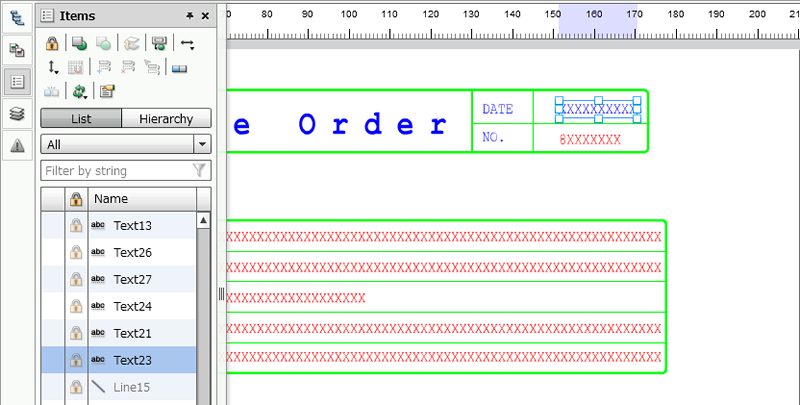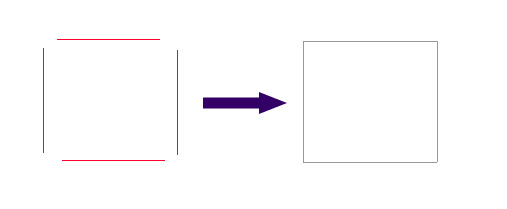4-5-5 Convert item types
In SVF Web Designer, you can convert selected items to another type of items and concatenate static texts.
You can convert items as follows:
Convert a field to static text.
Convert static text to a field.
Convert ruled lines (four straight lines) to a rectangle. (Four straight lines become the four sides of a rectangle).
Concatenate static texts.
Convert field to static text
Convert field to static text as follows:
Select the field to be converted.
Click the
 Convert item button on the Items window displayed by clicking the
Convert item button on the Items window displayed by clicking the  Items button, and click the
Items button, and click the  Convert field to static text button.
Convert field to static text button.The field is converted to static text.

Static text converted from a field
Reference
When you select multiple items that include a field and click the
 Convert field to static text button, only the field is converted to static text.
Convert field to static text button, only the field is converted to static text.The converted static text has the item name of "Text<last number>".
When a field is converted to a static text, the field property value is inherited to the static text property value. The following properties are inherited accordingly.
Property values other than those listed below reflect the default values for static texts set in Item default values. For details on the item default value setting of form definition, see "4-3-2 Set initial values of items".
Properties (for field) before conversion
Properties (for static text) after conversion
Remarks
Graphic mode
Graphic mode
X(dot)
X(dot)
Y(dot)
Y(dot)
Number of digits (print)
String
Set "X" for the number of print digits to String
If the Field type is Full-width, set a full -width "X", and if the field type is Half-width, set a half -width "X".
Pitch(dot)
Pitch(dot)
Fixed pitch
Fixed pitch
Full-width font
Full-width font
Half-width font
Half-width font
Font size
Font size
Vertical magnification
Vertical magnification
Horizontal magnification
Horizontal magnification
Text direction
Text direction
Rotation angle
Rotation angle
Bold
Bold
Italic
Italic
Outline
Outline
White-letter
White-letter
Shadow
Shadow
Outline width(dot)
Outline width(dot)
Mask/Image
Mask/Image
Gradation
Gradation
Gradation start color
Gradation start color
Gradation end color
Gradation end color
Gradation type
Gradation type
Common
Common
Select print page n
Select print page n
page: Color
page: Color
Convert static text to field
Use the following procedure to convert static text to a field:
Select the static text to be converted.
Click the
 Convert item button on the Items window, and click the
Convert item button on the Items window, and click the  Convert static text to field button.
Convert static text to field button.The static text is converted to a field.

Field converted from static text
Reference
When you select multiple items including static text and click the
 Convert static text to field button, only the static text is converted to a field.
Convert static text to field button, only the static text is converted to a field.The item name of the converted field will be "Field last number".
When converted from a fixed character to a field, the fixed character property value is carried over to the field property value. The following properties are inherited accordingly.
Property values other than those listed below reflect the default values for fields specified in Item default values. For details on the item default value setting of form definition, see "4-3-2 Set initial values of items".
Properties (for static text) before conversion
Properties (for field) after conversion
Remarks
Graphic mode
Graphic mode
X(dot)
X(dot)
Y(dot)
Y(dot)
String
Number of digits (print)
Only when all the character strings are full-width characters, set Field type in Full-width.
Pitch(dot)
Pitch(dot)
Fixed pitch
Fixed pitch
Full-width font
Full-width font
Half-width font
Half-width font
Font size
Font size
Vertical magnification
Vertical magnification
Horizontal magnification
Horizontal magnification
Text direction
Text direction
Rotation angle
Rotation angle
Bold
Bold
Italic
Italic
Outline
Outline
White-letter
White-letter
Shadow
Shadow
Outline width(dot)
Outline width(dot)
Mask/Image
Mask/Image
Gradation
Gradation
Gradation start color
Gradation start color
Gradation end color
Gradation end color
Gradation type
Gradation type
Common
Common
Select print page n
Select print page n
page: Color
page: Color
Convert lines into rectangle
Use the following procedure to convert four straight lines into a rectangle:

Convert four straight lines into a rectangle
Restriction
To convert into a rectangle, the four straight lines for the sides must all be either vertical or horizontal lines. If any of the four lines is diagonal, the lines cannot be converted into a rectangle.
To convert into a rectangle, the four straight lines for the sides must all be in the same hierarchy level. If any of the four lines is in a different hierarchy level, the lines cannot be converted into a rectangle.
You cannot convert any item to be repeated.
While pressing SHIFT, select four straight lines for the four sides of the rectangle.
Click the
 Convert item button on the Items window, and click the
Convert item button on the Items window, and click the  Convert lines into rectangle button.
Convert lines into rectangle button.The selected straight lines are converted into a rectangle.
Reference
The item name of the converted rectangle will be "Box last number".
The converted rectangle property reflects the default rectangle value set in Item default values.
For details on the item default value setting of form definition, see "4-3-2 Set initial values of items".
If you convert into a rectangle from straight lines placed in different layers, the converted rectangle item is placed in the layer that is active in the layer list.
If you convert a rectangle from straight lines placed on different multi-pages, the converted rectangle item is placed in the multi-page being edited.

Before conversion (left) After conversion (right)
Concatenate static texts
Use the following procedure to concatenate multiple static texts: This feature is supported by Service Pack 1.
Select static texts to concatenate.

Select multiple static texts
Click the
 Convert item button on the Items window, and click the
Convert item button on the Items window, and click the Concatenate static texts button.

Click the
"Concatenate static texts" button
The static texts is concatenated.

Concatenated static text
Restriction
You need to select two or more static texts.
You cannot concatenate locked static texts.
You cannot concatenate static texts included in repeat items.
You cannot concatenate static texts if the total number of characters exceeds 1000.
Concatenation rules
The concatenation rules are as follows:
The order of concatenation is the selecting order of items. In the case of range selection, it is the drawing order.
Characters are concatenated at the character string of the first static text. The pitch is automatically calculated in the range of corresponding items.
The property setting follows the setting of the first static text.
The first item is updated as a concatenated item, and the other items are deleted.
Reference
When the pitch calculation turns out to be a minus value, even if a graphic item, the minimum value is "0" and the characters are combined so that they do not overlap.
The origin position is for the first item, but if the first item is not placed at the upper-left corner (positionally top), an item is created with the first item as its origin.
In Thai language form files, calculate the pitch only when the half-width fonts are "Courier" or "OCRB".
If you concatenate items with different fonts, the pitch may not be calculated correctly to make the items fit in the overall size.